Western officials have ramped up a campaign of deception to provide a pretext for military intervention in Syria by pointing out the necessity of military action agains the Islamic terror group IS (Islamic State). The suggested actions against IS may well serve as a Trojan horse to escalate the war against the Syrian government.
The foundations of the campaign were laid in March, when US officials warned that Islamists bent on launching strikes against Europe and the United States were massing in Syria, and kicked into high gear with IS’s territorial gains in Iraq and the organization’s beheading of US journalist James Foley. Now US officials say they are considering air strikes against IS targets in Syria.
To justify the possibility of an air-war in Syria, US officials employ nebulous language about safeguarding US “security interests.” US defense secretary Chuck Hagel calls IS an “imminent threat to every interest we have,” adding that ISIS “is beyond anything that we’ve seen.” Hagel doesn’t say how IS is a threat to even one US interest, let alone all of them, while his elevation of IS to a threat “beyond anything that we’ve seen” is blatant, unabashed fear-mongering. Hagel also invokes the September 11, 2001 attacks in New York, usually a sign, that the public has to be prepared for military intervention.
France’s foreign minister, Laurent Fabius, utters a similar rallying cry, noting that “the attacks in New York on September 11, 2001, cost $1 million. Today, we estimate the Islamic State has several billions.” The obvious conclusion minister Fabius wants us to draw is that IS will launch hundreds or thousands of these attacks.
General Martin E. Dempsey, chairman of the US Joint Chiefs of Staff, declares that IS aspires to absorb “Israel, Jordan, Kuwait, and Syria into its caliphate,” and adds, that if IS “were to achieve that vision, it would fundamentally alter the face of the Middle East and create a security environment that would certainly threaten us in many ways.”
Former CIA director Gen. Michael Hayden also goes on air with a sober warning about possible IS attacks on targets in the USA or Europe. “IS is a very powerful local organization, and probably a reasonably powerful regional terrorist organization, [...] But it’s one that has global ambitions — and it has the tools.”
He says further: “There’s no more powerful way to express their street credentials among the jihadist community than a successful attack against the West,” finally concluding, that US airstrikes inside Syria, in addition to those being conducted in Iraq, would make a significant difference in the fight against IS.
Deputy national security adviser Ben Rhodes makes clear that going after IS forces based in Syria is an option: “We will do what’s necessary to protect Americans and see that justice is done for what we saw with the barbaric killing of Jim Foley. So we’re actively considering what’s going to be necessary to deal with that threat, and we’re not going to be restricted by borders.”
The media steps in
The media quickly picked up the cue and The Wall Street Journal suggested that James Foley’s beheading was reason enough to warrant US airstrikes on Syria. Until now beheadings, carried out by IS and other Islamists in Syria for a long time, have hardly lifted an eyebrow in Western media. Beheadings in other countries are also usually passed over silently, US ally Saudi Arabia beheaded at least 19 convicted criminals in the least weeks, nearly half of them for nonviolent offenses, including one for sorcery.
The New York Times reports that “The president and his top cabinet officials have all denounced the Islamic State as a medieval menace,” adding that “Secretary of State John Kerry said the group should be destroyed.” What the New York Times doesn’t point out is that Saudi Arabia is just as much a “medieval menace.” which underscores the reality that Washington bears no animus toward medieval menaces — not when, as in the case of Syria, they operate against the government of a country targeted for regime change, not when they govern a source of immense profits for Western oil companies, and not when, as in Afghanistan in the 1980s, they fight against a progressive, pro-Soviet government.
Reuters writes: “Extending the fight into Syria would allow opportunities for disrupting the group’s supply lines. Republican Senator John McCain told Reuters this week that Islamic State fighters have moved military equipment seized in the northern Iraqi city of Mosul into Syria and that they hold enclaves in Syrian territory that have been identified.”
The Washington Post writes: “…officials stressed that Obama has not made a decision to launch strikes in Syria — an action the administration has avoided since the start of that country’s civil war. But the video-recorded execution of American journalist James Foley this past week has prompted a reevaluation of the threat posed by the Islamic State, an al-Qaeda offshoot that holds other American hostages and controls territory across northern Iraq and Syria.”
The British Guardian titles its contribution to the campaign: “US ‘set to launch air strikes’ on senior Isis leaders in Syria,” and the paper concludes: “If Washington widened its attacks to extremists in Syria, this would mark a turning point, ending its hands-off approach to the country’s civil war.”
The propaganda campaign has not gone on unnoticed in non-Western media, Andrew Korybko of Ria Novosti writes:
The US info war against Syria has just reached a new, heightened phase. It is depending on a strong and emotional public reaction to Foley’s widely disseminated beheading to coalesce support for military strikes against Syria on anti-terror grounds. This is nothing more than convenient window dressing to cover up a regime change operation against Assad and fulfill the US’ original objective in Syria. Foley’s beheading is being used as the ultimate backdoor attempt to wage war against Syria, as prior to his death, it would have been political fantasy for one to seriously consider a US anti-terror campaign in the country, let alone one launched from Iraq. Thus, the world is witnessing a dangerous escalation of the info war against Syria, where tempting humanitarian and anti-terror justifications are being used to launch another attempt at regime change.
IS, a creation of the West
Until now the Wester powers were perfectly willing to allow, indeed, even to foster “the cancer of IS” (as it is now called in one of the newest catch-phrases), to metastasize throughout Syria. They expressed no apprehensions then about IS threatening attacks on the United States, and did nothing to stop the flow of money to the anti-Assad group from supporters in the Gulf monarchies.
IS has demonstrated its savagery and disregard of human life for a long time. The terror groups brutality in Iraq, its beheading of journalist Foley, and its ability to seize and hold territory, have been no more shocking than what has going on in Syria for three year, where IS and its fellow Islamists have carried out equally bloody displays of depraved cruelty, while seizing and devastating large swathes of territory, amply assisted by Turkey, Jordan, the Gulf monarchies, the USA, and NATO allies Britain and France.
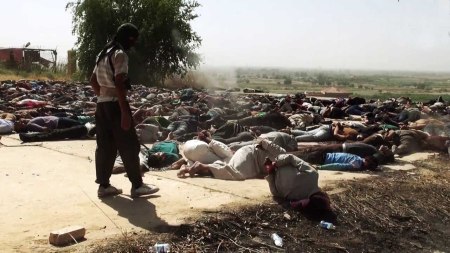 The evidence is circumstantial, but all known facts from funding IS by Saudi Arabia via Kuwait to the significant logistic help from Turkey suggest that IS is a covert US operation.
The evidence is circumstantial, but all known facts from funding IS by Saudi Arabia via Kuwait to the significant logistic help from Turkey suggest that IS is a covert US operation.
Who pays?
Wester media pundits suggest, that the group generates most of its funding from protection tax, Islamic tax (jizya), kidnapping, extortion, looting, and smuggling. The looting of Mosul’s banks is cited as an important source.
Luay Al Khatteeb of the Brookings Doha Centre says, that IS is reportedly smuggling via Turkey every day around 30,000 barrels of oil, generating 2 million US$ revenue.
All these criminal activities, which undoubtedly are taking place, cannot explain the nearly unlimited funds of IS.
Germany’s Development Minister Gerd Mueller is suggesting, that Qatar also could be supporting the group. Qatar has evidently sent cash to all Islamic terror groups in Syria, but even more donations came from Saudi Arabia and the UAE. The money is channeled via Kuwait, whose banking system is the main conduit for funds to Islamic groups all over the word. It is said that the money comes from rich individuals and not from the governments, but in autocratic and tightly controlled states like the Gulf monarchies such donations would not be possible without tacit approval by the authorities.
Saudi Arabia, the UAE, Kuwait, Qatar are all carefully monitoring their financial sector and can easily prevent any unwanted transfers.
Where do IS fighters come from?
A quarter of IS fighters are Turkish and IS ranks also include at least 3,000 Europeans. The group has been joined by so many foreigners who do not speak Arabic that some units need to employ translators to ensure orders are understood.
A documentary by Vice found one Islamic State unit in Syria that had to have interpreters who could speak Russian, English, French, and Dutch. Many of these fighters are not Islamic fanatics but simply mercenaries.
Who provides the weapons?
Recently, when the US State Department resumed sending so called non-lethal aid to Syrian rebels, the delivery list included 43 Toyota Hilux trucks. These are iconic off-road vehicles used by insurgency groups around the word. They can easily be mounted with crew-served machine guns or other type of military equipment. From the Toyota brochure: Toyota Hilux. An unstoppable pick up with legendary 4×4 capabilities and outstanding reliability. Hilux is tough, versatile and comfortable.
There are hundreds of pictures in which IS troops parade in columns of brand new Toyota Hilux trucks and one can easily guess where the vehicles came from.
There are also pictures of IS troops in M1 Abrams tanks, T-55 Tanks, T-72 tanks, personal armored carriers, Humvees, 155mm M-198 artillery batteries, and at least one SCUD missile.
Many of these pictures on the internet date from before the fall of Mosul, which makes one wonder…
SA-7 surface-to-air missiles, BM-21 Grad multiple rocket launchers, Fim-92 Stinger Manpad shoulder missiles, ZU-23-2 anti-aircraft guns, M79 Osa, HJ-8, and AT-4 Spigot anti-tank weapons are also available to IS. Some reports speak of IS helicopters.
The suggestion that this is all captured equipment is ridiculous.
Who trains IS?
IS fighters suddenly are able to handle armored personal carriers, tanks, self propelled artillery, MANPATS, etc. Nobody asks where they learned to do that. Other people need month of training to use this weapons.
The Washington Post writes: The CIA has also expanded its network of informants inside Syria, largely by recruiting and vetting rebel fighters who have been trained and equipped at clandestine agency bases in Jordan over the past two years.
There are numerous reports about the training base Safawi in Jordan’s northern desert region and extensive drill and instruction in three other camps. Training is also provided in the US Incirlik Air Base near Adana, Turkey, and in many Syrian refugee camps in Turkey and Jordan.
Most of the “carefully vetted” rebel fighters have joined the ranks of IS, where they are highly respected for their expertise, get a good salary, and have the newest equipment at their disposal
Tom Engelhardt, an icon of the US blogger scene writes:
Think of it this way: first Washington provides the Iraqi military with training and massive infusions of military equipment to the tune of $25 billion. Next that military, faced with its first serious opposition, the militants of the Islamic State of Iraq and Syria (ISIS), numbering in the thousands against security forces in the hundreds of thousands, collapses. In June, two full divisions, 30,000 Iraqi troops, flee the city of Mosul, abandoning their posts in the face of the advance of ISIS fighters. In all, four divisions of the country’s 14-division army disintegrate throughout the north. Left behind is a massive trove of US-supplied weaponry, including 1,500 Humvees, 52 US-made M198 howitzers, tanks, trucks, rifles, and ammunition.
ISIS militants, who seem remarkably capable of operating such equipment without an American trainer or adviser in sight, then turn some of that weaponry (as well as weapons captured from the Syrian military) on US-backed forces, including, in the north, Kurdish peshmerga militias. (They have evidently even brought tanks into play near the Turkish border.)
Tom Engelhardt may have earned his laurels as a (moderate) critic of US imperialism, but he is not able to draw the apparent conclusion that without covert operations, mainly bribing high ranking Iraqi officers and providing intelligence to IS, the Iraqi military would not have collapsed, and without solid training by US special teams the IS fighters would not be able to operate the newly acquired equipment.
Who provides logistic support
When IS captured Mosul, the Turkish consulate there became its interim headquarter and the 49 consulate workers were taken hostage — at least that is what the Turkish government said. 28 Turkish truck drivers who were transporting diesel to Mosul were also abducted.
After the (so called) abduction a media blackout was imposed and coverage stopped. Turkish Prime minister Erdogan refrained from any criticism of IS and called it (and still calls it) an organization. Considering all the signs it seems more than likely that the consulate staff and also the (nominally) abducted truck drivers now work for IS on behalf of the Turkish authorities.
A senior IS commander, called Abu Yusaf, told in an interview: “We used to have fighters — even high-level members of the Islamic State — getting treated in Turkish hospitals [...] And also, most of the fighters who joined us in the beginning of the war came via Turkey, and so did our equipment and supplies.”
Bilal Erdogan, President-elect Recep Tayyip Erdogan’s son, plays an important role in IHH (Foundation for Human Rights and Freedoms and Humanitarian Relief), an Islamic charity which allegedly raises funds for and provides material assistance to IS. IHH had an annual budget of more than 100 million US$.
An IHH truck was stopped by the gendarmerie near Adana in Hatay in January 2014. It was loaded with arms and ammunition destined for Syria. The Hatay public prosecutor tried to launch an investigation, but was blocked. When he filed a criminal complaint alleging obstruction of justice by Turkey’s Interior Minister and the MIT, he was dismissed. The policemen who stopped the vehicle were fired. The Hatay governor said the operation was a “state secret.”
Ammunition was also found on two passenger buses heading to Syria. Officers from the antiterrorism branch of the Adana Police Department released photos of ammunition on the buses to the media. They too were fired.
Cengiz Candar, one of Turkey’s most respected journalists recently wrote that Turkey’s Intelligence Agency MIT was the “midwife” that helped birth IS. Beginning in 2012, according to Candar, Turkey gave weapons and logistical support to jihadis fighting the Syrian regime, including IS. While Saudi Arabia, Qatar, and the UAE provided funds Turkey coordinated the travel, payments, and weapons supplies.
Police officers report the steady flow of unmarked trucks in Adana, Kilis, Gaziantep, and Kayseri — towns near the border with Syria. They believe the trucks are transporting weapons. Residents of Kilis describe routine interaction between Turkish officials on one side of the border and IS on the other.
According to a Turkish doctor, Turkish ambulances deliver war-wounded to Turkish hospitals on the border with Syria. They have no papers or identification. The Ministry of Health covers their expenses. The notorious IS commander Abu Muhammed was photographed receiving treatment at the Hatay State Hospital in April 2014.
Who pulls the strings?
IS is not only supported by the West, it is most likely a special creation of the West, designed to encircle and weaken Iran by destabilizing Syria, Iraq, and Lebanon. Saudi Arabia is bankrolling it, Turkey provides logistic support and a deployment zone, the USA coordinates and helps with intelligence from spy satellites, surveillance drones, and CIA/NSA data gathering.
Francis Boyle, a constitutional scholar and law professor at the University of Illinois, voices the opinion, that IS is a covert intelligence operation by the USA which aims at setting a predicate for further military inervention in Iraq and Syria.
There are reports which suggest that IS’s leader, Abu Bakr al-Baghdadi, was trained by the Israeli Mossad in psychological warfare and that he is essentially an actor playing the role of an “Islamic radical.” Abu Bakr Baghdadi spent five years in a US detention facility, and also three of his four military commanders were at one time in detention by US forces.
The fall of Mosul and the sudden dissolution of the Iraqi army looks like a typical CIA operation, who may have bribed the high ranking officers of the Iraqi army with suitcases full of banknotes. The CIA did such things during the US occupation of Iraq, when it organized the then called “uprising.”
The precise military operations and surprise attacks at the weakest points in the enemy frontline can only be explained by superb intelligence provided with the help of US spy satellites and surveillance drones. The USA launches dozens of spy satellites every year equipped with high resolution cameras which can identify objects down to 20 cm. The satellites have also infrared sensors which can even detect isolated small arms fire.
The information from satellites and drones is most likely analyzed in the US and transferred to the US embassy in Ankara. Ambassador Francis J. Ricciardone is allegedly leading a control room there where the exact military operations of IS are designed.
Misinformation, deception, and smoke screens
It is traditional US diplomacy to play a double game — on the one hand training, arming, and financing terrorists to overthrow or destabilize non-compliant governments, while at the same time condemning those same malcontents when it is convenient to do so. Al-Qaeda got its start as CIA mercenaries against the Soviets in Afghanistan in the 1980s. That fact didn’t stop President Bush from his fraudulent “war on terror,” vowing to eliminate the CIA’s very own Frankenstein creation.
Everything that is written about IS seems to be disinformation and cover-up. Western journalists know that IS is huge and that it is in essence a covert US-operation, so they do anything to obscure and blur the facts and confuse their readers.
Mohammad Ballout, correspondent of As-Safir in Paris, claims that the US has been providing intelligence to the Syrian regime regarding positions of IS in Syria, while Ghaleb Kandil, another Lebanese journalist with close ties to the Syrian government, says the West would be forced to deal with Assad sooner or later. In return for security cooperation, Assad would demand full political rehabilitation.
This is completely out of the question and a rapprochement with Assad will not happen. These are planted misinformations to muddy the waters. It is, as already stated above, more likely that IS gets information about Syrian Army movements via the US embassy in Ankara.
Various commentators suggest, that IS and the Syrian government are cooperating to destroy the so called “moderate rebels.” This allegation is disproved alone by the intense fighting over the Tabqa airbase, where some 360 IS fighters and 170 Syrian soldiers have been killed. The base has unfortunately fallen, though fighting is still going on.
The numbers of IS fighters has for years been downplayed and estimated by Western “experts” to be between 6,000 and 9,000 fighters. Suddenly the estimates are corrected upward to between 20,000 and 40,000 fighters, with nobody explaining how this sudden increase is possible.
According to the US administration, the US Air Force has conducted 90 airstrikes in order to stop IS’s progress in the region. The operations aim is restricted to protect US personnel at the consulate in the Kurdish capital Erbil and prevent the genocide of the Yazidi minority, though the strikes are now said to hit also IS targets near the Mosul Dam.
Yet there are no pictures of destroyed IS-equipment, only one lonely picture on NPR depicts an overturned IS car and some pictures show clouds of smoke. Where is the proof of the alleged damage to IS? With 90 airstrikes conducted, there should be ample material about the caused destruction.
Not only is the US air operation limited and maybe only a staged show, the USA has refused Iraq’s plea for help against IS, it has not delivered promised F-16 fighter jets and Iraq has to rely on quickly supplied Russian SU-25.
In light of the above, it is obvious, that the suggested US air-strikes in Syria, once they have started, will expand their target list from IS to Syrian government forces, if IS positions are bombed at all. The campaign to mobilize public support for an air war against IS in Syria is a Trojan Horse to escalate the war against the Assad government, and on a broader level, against the interlocked Hezbollah-Syria-Iran resistance which until now prevented a complete US/Israeli domination of the Middle East.
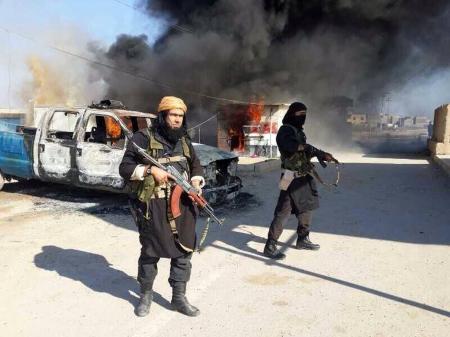
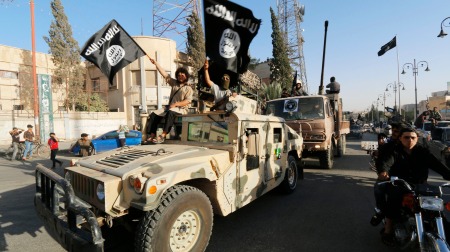
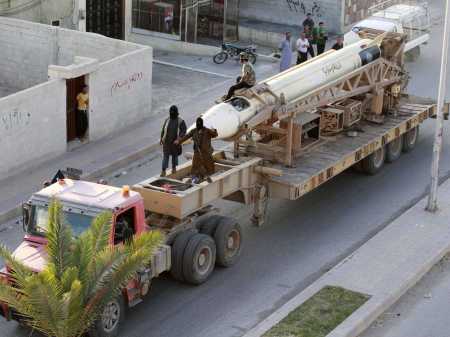
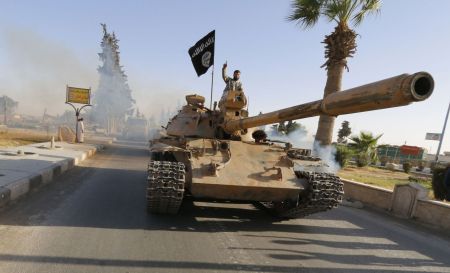


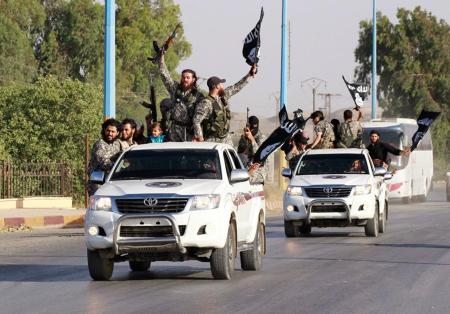
Keine Kommentare:
Kommentar veröffentlichen